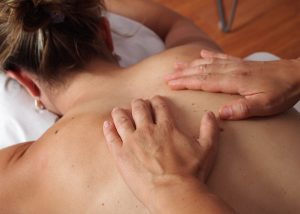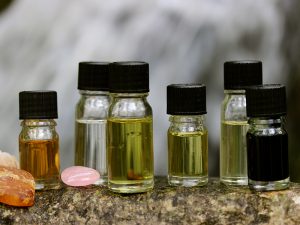- info@aromantique.co.uk
- 07419 777 451
Aromatherapy generally combines the tactile medium of touch (through massage) with essential oils to engender a state of deep relaxation to enhance a sense of peace and wellbeing within the recipient, and improve immunological homeostasis.
Employing their antimicrobial, skin and tissue healing qualities, essential oils may be applied alone (dilute in a vegetable medium such as oil, lotion or cream) to the skin, dilute in gels, ointment and compresses to treat local conditions, such as eczema, sprains, insect bites and improve scar tissue.
Essential oils are also applied using none-tactile methods of application. For example: vaporisation (room diffuser and/or tissues); aroma sticks (nasal inhalers); ‘therapeutic perfumes’; and steam inhalation – respectively, to provide an ambient room scent, relief from symptoms of a cold or sore throat, or to uplift, calm, and energise mood and positive emotion, among other reasons.
How do I book an appointment?
Email or phone (call-back service if you leave a message) – heather@aromantique.co.uk / 01297 598080 (63a Silver Street, Lyme Regis, DT7 3HR)
How long will my aromatherapy massage last?
Full body massage usually lasts for 60 minutes (areas massaged: back, legs, feet, arms, hands, head, face, neck, shoulders – abdomen optional). Your appointment will include time for consultation and preparation of your essential oil blend.
 How can aromatherapy massage help me?
How can aromatherapy massage help me?
Aromatherapy massage tends to incorporate an eclectic range of techniques that are gentle yet also stimulating (these can include Swedish, Acupressure or Shiatsu-like movements). The aim of aromatherapy massage is to de-stress body, mind and emotion (uplift, balance and/or ground mood to instil a sense of calm and peace), gently stimulate lymph-vascular circulation, support the immune system, relax muscles and improve skin and soft tissue tone.
A select personalised blend of essential oils is blended in a carrier medium, such as grape seed or olive oil, or sometimes lotion or cream; selection will depend on the area being massaged, and the condition of the skin, for example, dry, mature, normal, and so on.
Aromatherapy is very useful for:
Is it ok to receive a massage if I have just eaten?
It is ok if you have just had a snack. However, it is not ok if you have just eaten a large or heavy meal – in this case, it is best to allow 45 to 60 minutes before you receive your massage. Drinking water, herb tea, or fruit juice is fine, in fact, it is desirable, to ensure you are sufficiently hydrated (although you may need to use the loo before you attend your massage appointment…just in case)
I am pregnant. Can I receive an aromatherapy massage?
As long as there are no complications with your pregnancy, yes, it is fine to receive an aromatherapy massage after the first trimester. Your massage will be adapted accordingly, and selection of essential oils will be modified. However, your therapist reserves the right not to provide an aromatherapy massage if it is deemed inappropriate or unsafe for any reason at any given time.
When is it not ok to receive aromatherapy massage?
In most instances aromatherapy massage is extremely beneficial (for all of the above mentioned reasons). However, there are times when massage is counterproductive, undesirable, or may cause harm or exacerbate an underlying condition. For example, you should not receive a massage if you:
Also, there are certain instances when an essential oil may not be suitable for you. For example, again, if you are pregnant, or if you are taking medication that might be compromised by an essential oils chemical constituents. For example, if you are pregnant, it is not advisable to use herbaceous oils and oils with strong hormonal stimulating properties; if you are taking codeine (which contains opiates), it is not advisable to use chamomile German or yarrow.
This is why a consultation is always carried out by the therapist before essential oils are selected and an aromatherapy massage is applied.
 What are essential oils?
What are essential oils?
Essential oils comprise of a highly concentrated mixture of various volatile chemical components extracted from plants and their parts (leaves, fruits, flowers, bark, roots and so on).
Essential oils demonstrate similar qualities to those exhibited by the plant they are extracted from. However, they are not the same when removed from the plant. Plants and herbs contain many other non-volatile and inorganic components which influence it’s therapeutic qualities, and which also balance, calm, or antidote irritant or toxic components. For this reason, essential oils must be regarded separately according to their individual, unique chemical composition. Also, in isolation from the plant, and because they are highly concentrated, essential oils will irritate skin and mucus membrane.
When prescribed by a pharmacist or herbalist for internal ingestion, essential oils are applied in small controlled amounts, and are contained in a ‘safe to swallow’ gel-like capsule, preferably of vegetable origin (composed of hypromellose, a polymer formulated from plant cellulose). Geletine is the derived from animal skin or bone collagen.
Essential oils are hydrophobic, which means they do not dissolve in water; essential oil molecules will cluster together and float on the surface of water, or sink to the bottom (of water stored in a container). While they are oil-like in their behaviour (i.e. they do not mix with water), however, they are not ‘greasy’ or ‘oily’ in the way that fat or vegetable oils are. They are not lubricant, in fact, are extremely drying to the skin. This is why essential oils are always blended in an emollient, such as a vegetable oil, ointment, cream or lotion, when applied to the body. Emollients can also add their own unique qualities to a blend, especially when considering skincare and skin healing.
Essential oils influence and support the immune system (they are anti-microbial, for example), they are skin healing, and directly influence the Limbic System (the instinctive and emotional centre) within the brain, and have psycho-emotional qualities. They instigate physiological and neural responses (via olfactory receptors found throughout the body). Applied appropriately, essential oils are highly beneficial.
 What is an absolute?
What is an absolute?
Solvent extraction is similar in principle to distillation, but instead of applying water or steam to extract the volatile essential oils from plant material, a chemical substance (for example, acetone, hexane, or toluene) is used to ‘soak out’ the essential oil. The end product of this process is known as an ‘absolute’. An absolute is not an ‘essential oil’ in its purest sense.
Solvent extraction is less aggressive and heat intensive than distillation, and is reserved for plants that are destroyed by intense heat, especially delicate flowers and blossoms, such as, for example, rose and jasmine (although both are also distilled).
Absolutes also contain non-volatile, non-water loving, and inorganic components that are usually left behind during steam distillation. They are viscous and deeply coloured. Their perfume is often stronger and more intense than steam distilled essential oils, and closer to the plants original scent profile; which is why absolutes are preferred by the perfume industry.
Absolutes are more likely to cause skin irritation, sensitisation, and allergic reaction.
What is lavender 40/42?
Lavender 40/42 is a standardised essential oil; that is, it’s chemical composition is always the same. 40/42 relates to the ratio of linalool and linalyl acetate, which are the predominant chemical ingredients of lavender essential oil; in order to achieve the standardised 40/42 ratio, these constituents are either reduced, or added to.
Lavender 40/42 essential oil often comprises of a blend of lavender from more than one source. Synthetic linalool and linalyl acetate may be added too.
Lavendula Angustifolia ‘Maillette’ is a cloned (cultivar) lavender species produced to replicate the standardised 40/42 linalool/linalyl balance. This species has a stronger, more intense, and sweet scent and is mostly grown for the perfume industry.